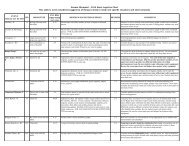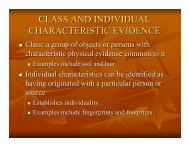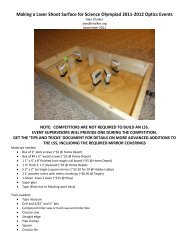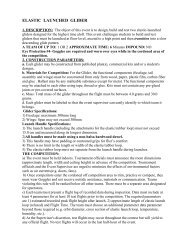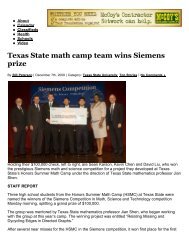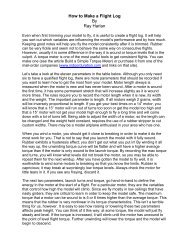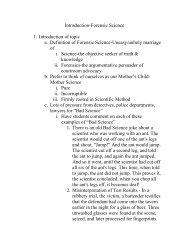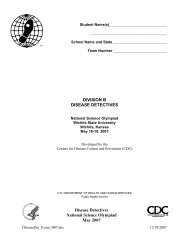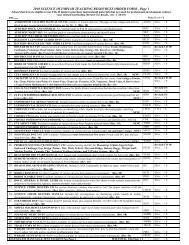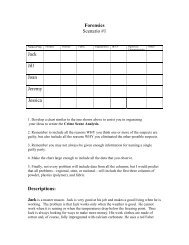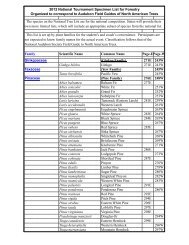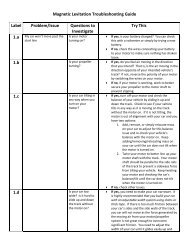Sound of Music - Science Olympiad
Sound of Music - Science Olympiad
Sound of Music - Science Olympiad
You also want an ePaper? Increase the reach of your titles
YUMPU automatically turns print PDFs into web optimized ePapers that Google loves.
Trial/Pilot EventContact the organizers <strong>of</strong> your tournament to find out what trial/pilot events will be held.SOUNDS OF MUSIC1 DESCRIPTION: Prior to the competition each team will build two types <strong>of</strong> musical instruments [aerophone, chordophone,ideophone, or membranophone (see soinc.org for descriptions)] based on a 12 tone tempered scale, prepare to describe theprinciples behind their operation and be able to perform a major scale, a required melody and a chosen melody.A TEAM OF: 2APPROXIMATE TIME: 20 min/Set-up 5 min2 EVENT PARAMETERS: Teams must provide a score <strong>of</strong> all music to be performed and submit it in notated form at thebeginning <strong>of</strong> their presentation. All music submitted must be written in the appropriate clef for each <strong>of</strong> their musical instrumentsas stated in the chart below. Each member will play at least one instrument. No notes, calculators, books, etc. will be allowed.Trial/Pilot3 THE COMPETITION:a. Each team member must play the required scale as given in the following chart and will be evaluated on range, pitch, andsound quality. However, to help teams select music and to improve their overall score they may wish to include notes withinthe maximum allowable scoring range. Corresponding frequencies for each note below have been rounded to the nearestwhole number.EventScale Instrument 1 Instrument 2Mandatory Scale C major (C4 [262 Hz] to C5 [523 Hz]) G major (G2 [98 Hz] to G3 [196 Hz])Allowable Scoring Range F3 [175 Hz] to G5 [784 Hz] C2 [65 Hz] to D4 [294 Hz]<strong>Music</strong> submitted in Treble Clef Bass Clefb. Members will also be asked to play any note from the required scale and the judge will determine its accuracy. No electric orelectronic devices, toy or pr<strong>of</strong>essional instruments or parts <strong>of</strong> such instruments will be permitted including items such as bells,whistles, mouthpieces, reeds or reed blocks, audio-oscillators, rosin, tuning pegs, etc. The only exception is that strings(instrument or others) <strong>of</strong> any type are permitted. No electricity is allowed. All energy put into the instruments must originatedirectly from the students.c. Instruments will also be evaluated on creativity and originality, variety and workmanship.d. The students will be asked to describe the scientific principles used in the design and construction <strong>of</strong> the device. (e.g., Howdoes it make a sound? What determines the pitch <strong>of</strong> a note? How is volume changed?). This will be done as an oral interviewand/or with a written set <strong>of</strong> questions. Students must be able to define or explain basic terminology regarding sound, soundproduction, and related science terms. These include but are not limited to fundamental elements <strong>of</strong> wave theory, BernoulliEffect, acoustics, musical sound perception, and harmonics.e. The team will then perform, in any key within the musical ranges specified, the lines <strong>of</strong> music included below. The piece will beplayed as a duet including melody and harmony. Students must supply their own harmony. Each instrument must be capable<strong>of</strong> playing the required lines as written or as transposed into a key adapted to their instrument but staying within the allowablerange. They will also play a duet <strong>of</strong> their choosing which best demonstrates the capabilities <strong>of</strong> their instruments. Students willbe given a maximum <strong>of</strong> four (4) minutes to play both the required duet and the chosen duet.4 SCORING: All scoring will be done by the same set <strong>of</strong> judges (preferably 2-3). If more than one person is judging, the average<strong>of</strong> all judges’ scores will be the final score for the team. Judges will have knowledge <strong>of</strong> both music and the physics <strong>of</strong> sound.a. Range <strong>of</strong> notes: quality <strong>of</strong> sound (22 points)i. Demonstrated range ____ octaves (for instrument #1) ____ notes _____ Points (6)ii. <strong>Sound</strong> quality (compared to standard instruments #1) _____ Points (5)iii. Demonstrated range ____ octaves (for instrument #2) ____ notes _____ Points (6)<strong>Sound</strong>s<strong>of</strong><strong>Music</strong>C.doc 5/30/2008Copyright © 2008, <strong>Science</strong> <strong>Olympiad</strong> Inc - All Rights Reserved
Trial/Pilot EventContact the organizers <strong>of</strong> your tournament to find out what trial/pilot events will be held.iv. <strong>Sound</strong> quality (compared to standard instruments #2) _____ Points (5)b. Creativity, variety, and workmanship <strong>of</strong> instruments (25 points)i. Originality/creativity (traditional/unusual) _____ Points (10)ii. Variety (percussion, wind, brass, string, other) _____ Points (5)iii. Workmanship (appearance, easy to play, durability, etc.) _____ Points (10)c. Knowledge <strong>of</strong> theoretical basis <strong>of</strong> instruments (30 points) _____ Points (30)Trial/PilotIncludes participation <strong>of</strong> both team members and an explanation <strong>of</strong> simple mathematical and physical principles <strong>of</strong> sound. Thiswill be conducted as an interview/written test with approximately 3 to 6 pre-selected questions adaptable to variousinstruments.d. <strong>Sound</strong> <strong>of</strong> the ensemble (25 points) Group Performance points for both required/chosen songs will be basedon harmony, blend, technique, timbre, suitability <strong>of</strong> tune for instruments, rhythm, interpretation <strong>of</strong> music, etc.i. Group Performance for the required song (10 points) _____ Points (10)ii. Group Performance for the chosen song (15 points) _____ Points (15)Evente. Bonus Points: Each <strong>of</strong> the following will receive the specified bonus points.i. Teams that follow all <strong>of</strong> the rules _____ Points (16)ii. Teams that furnish music for the judges with team name and number _____ Points (8)iii. Teams that write their music in the correct clefs and correctly notated _____ Points (8)iv. Teams that play all music in the correct range _____ Points (8)v. Teams that use only allowed materials in building and playing _____ Points (8)Required SongSuggested references: <strong>Music</strong>al Instrument Design by Bart Hopkin, See Sharp Press, 2000, $18.95. Making Simple <strong>Music</strong>al Instruments byBart Hopkin, Altamont Press, 1995, $24.95. National <strong>Science</strong> Education Standards: / CONTENT STANDARD E: All students shoulddevelop abilities <strong>of</strong> technological design and understandings about science and technology.See: http://www.soinc.org/events/sounds/index.htm<strong>Sound</strong>s<strong>of</strong><strong>Music</strong>C.doc 5/30/2008Copyright © 2008, <strong>Science</strong> <strong>Olympiad</strong> Inc - All Rights Reserved



